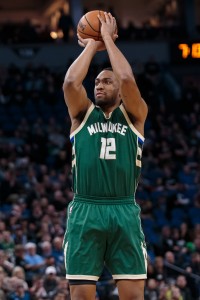At the start of the 2017 NBA offseason, 20 players eligible for restricted free agency received qualifying offers from their respective teams. Two months after the free agent period officially got underway, a handful of those players remain unsigned, while the rest have had their contract situations resolved for the coming season.
Here’s a breakdown of what has happened this summer with those 20 players:
Ron Baker (Knicks)
Baker’s new pact was among the first batch of deals revealed following the start of the free agency period. It wasn’t until August, however, that the contract was made official.
Re-signed: 2 years, 9MM
Bojan Bogdanovic (Wizards)
With bigger fish to fry this offseason, the Wizards withdrew their qualifying offer for the 28-year-old Bogdanovic. Almost immediately after, the Pacers emerged as contenders for the free agent sharpshooter.
QO Rescinded, Signed with Pacers: 2 years, $21MM
Kentavious Caldwell-Pope (Pistons)
When the Avery Bradley trade fell in their lap, the Pistons rescinded their qualifying offer to the man that Bradley would be replacing. Within a week, Caldwell-Pope signed with the Lakers on a one-year deal, which will give him another crack at free agency next summer.
QO Rescinded, Signed with Lakers: 1 year, $18MM
Nando De Colo (Raptors)
The Raptors extended a qualifying offer to De Colo in order to maintain his rights should be ever return to the NBA. The 30-year-old has played overseas since 2014/15, and will remain with CSKA Moscow for the coming season.
Unsigned: $1.8MM QO Extended
Cristiano Felicio (Bulls)
The Bulls wasted no time coming to terms with Felicio. Almost immediately after the free agent period opened, it was reported that the 25-year-old would be returning to Chicago.
Re-signed: 4 years, $32MM
JaMychal Green (Grizzlies)
Green remains unsigned through early September as the Grizzlies have been reluctant to meet the forward’s contract demands. Last week we wrote that Memphis is apparently willing to offer more than the qualifying offer.
Unsigned: $2.8MM QO Extended
Tim Hardaway Jr. (Hawks)
A few days into free agency, the Knicks dropped a bombshell on Hawks fans, extending an exorbitant offer sheet to the 25-year-old shooting guard. Within two days, Atlanta elected not to match.
Unmatched Offer Sheet (Knicks): 4 years, $71MM
Joe Ingles (Jazz)
The Jazz extended the versatile Ingles a respectable offer almost immediately after free agency began. Three weeks later, when dust from Gordon Hayward‘s exit began to settle, the parties made it official.
Re-signed: 4 years, $52MM
Joffrey Lauvergne (Bulls)
It’s not clearly exactly why but the Bulls withdrew their qualifying offer for Lauvergne, but the fact that they were able to secure Cristiano Felicio to a four-year deal may have contributed to the decision. Lauvergne signed on with the Spurs in the middle of July.
QO Rescinded, Signed with Spurs: 2 Years, $3MM
Alex Len (Suns)
The Suns have a solid young core that they’re focused on developing and it’s unclear whether Len fits into that or not. The Suns have plenty of cap flexibility to bring him back, but nothing has been reported about those negotiations as of late.
Unsigned: $4.2MM QO Extended
Nikola Mirotic (Bulls)
The Bulls are apparently interested in bringing Mirotic back, but clearly didn’t race out to throw big money in his direction. While the 26-year-old big man could slot into Chicago’s rebuild, the organization has little incentive to overpay for him, considering the club’s current state of affairs.
Unsigned: $7.2MM QO Extended
Shabazz Muhammad (Timberwolves)
The Timberwolves initially extended a qualifying offer to Muhammad but withdrew it in order to free up the cap space to sign Taj Gibson. A possibility of him returning to Minnesota has been floated and he’s also been linked to the Lakers.
QO Rescinded: Available
Nerlens Noel (Mavericks)
Noel’s camp came out seeking big money for the 23-year-old, but the parties never came to terms. Fast forward two months and one change in representation later and the big man had little choice but to bet on himself and accept the qualifying offer.
QO Signed: 1 year, $4.2MM
Kelly Olynyk (Celtics)
The Celtics needed to rescind their qualifying offer to Olynyk in order to sign Gordon Hayward. Having missed out on Hayward themselves, the Heat moved quickly on Olynyk when he became unrestricted and officially signed him a few days later.
QO Rescinded, Signed with Heat: 4 years, $46MM
Mason Plumlee (Nuggets)
The Nuggets paid a substantial price for Plumlee in a midseason trade but haven’t rushed to lock him in for next season. Denver supposedly views the big man as a part of their core, but there has been little reported progress toward an agreement, and Paul Millsap‘s arrival makes Plumlee’s role in Denver murkier.
Unsigned: $4.6MM QO Offered
Otto Porter (Wizards)
The Wizards were willing to let the market dictate Porter’s price tag and didn’t hesitate to match when the forward earned max money through an aggressive offer sheet from the Nets.
Matched Offer Sheet: 4 years, $107MM
Andre Roberson (Thunder)
It only took a few days for the Thunder to come to terms with Roberson on a long-term deal and a week later the two parties finalized it.
Re-signed: 3 years, $30MM
Jonathon Simmons (Spurs)
The Spurs surprised many when they withdrew Simmons’ qualifying offer but it was quickly revealed that the request came from the free agent’s own camp. Within days, the shooting guard signed on with the Magic.
QO Rescinded, Signed with Magic: 3 years, $18MM
Tony Snell (Bucks)
The Bucks came to terms with restricted free agent almost immediately after July 1. The revelation of the signing was Adrian Wojnarowski’s first Woj Bomb of his ESPN tenure.
Re-signed: 4 years, $44MM
Alan Williams (Suns)
About a month into free agency, the Suns came to terms with Williams and the second-year forward jumped at a three-year offer. Only the first year of the undrafted big man’s contract is guaranteed.
Re-signed: 3 years, $17MM
